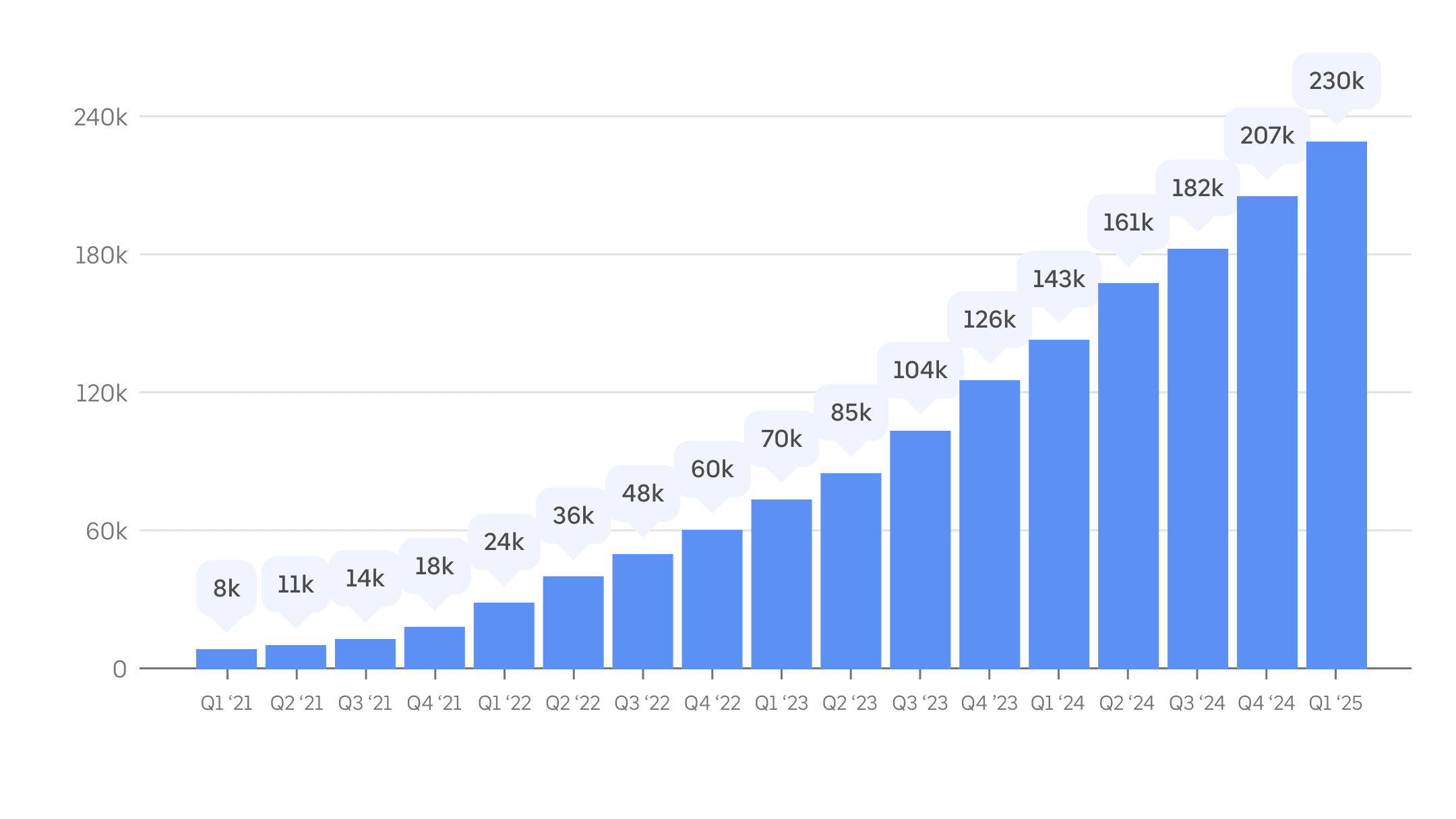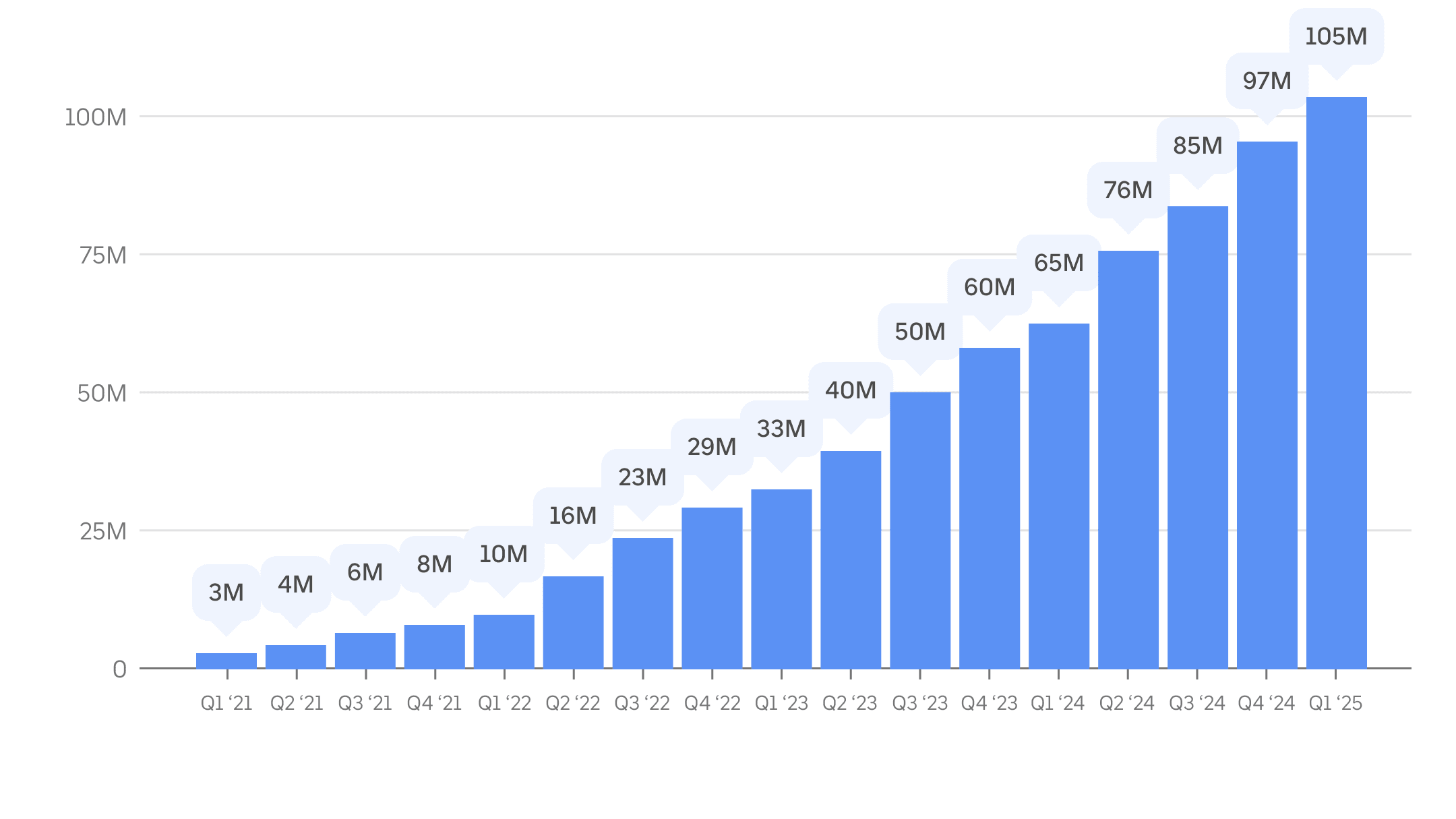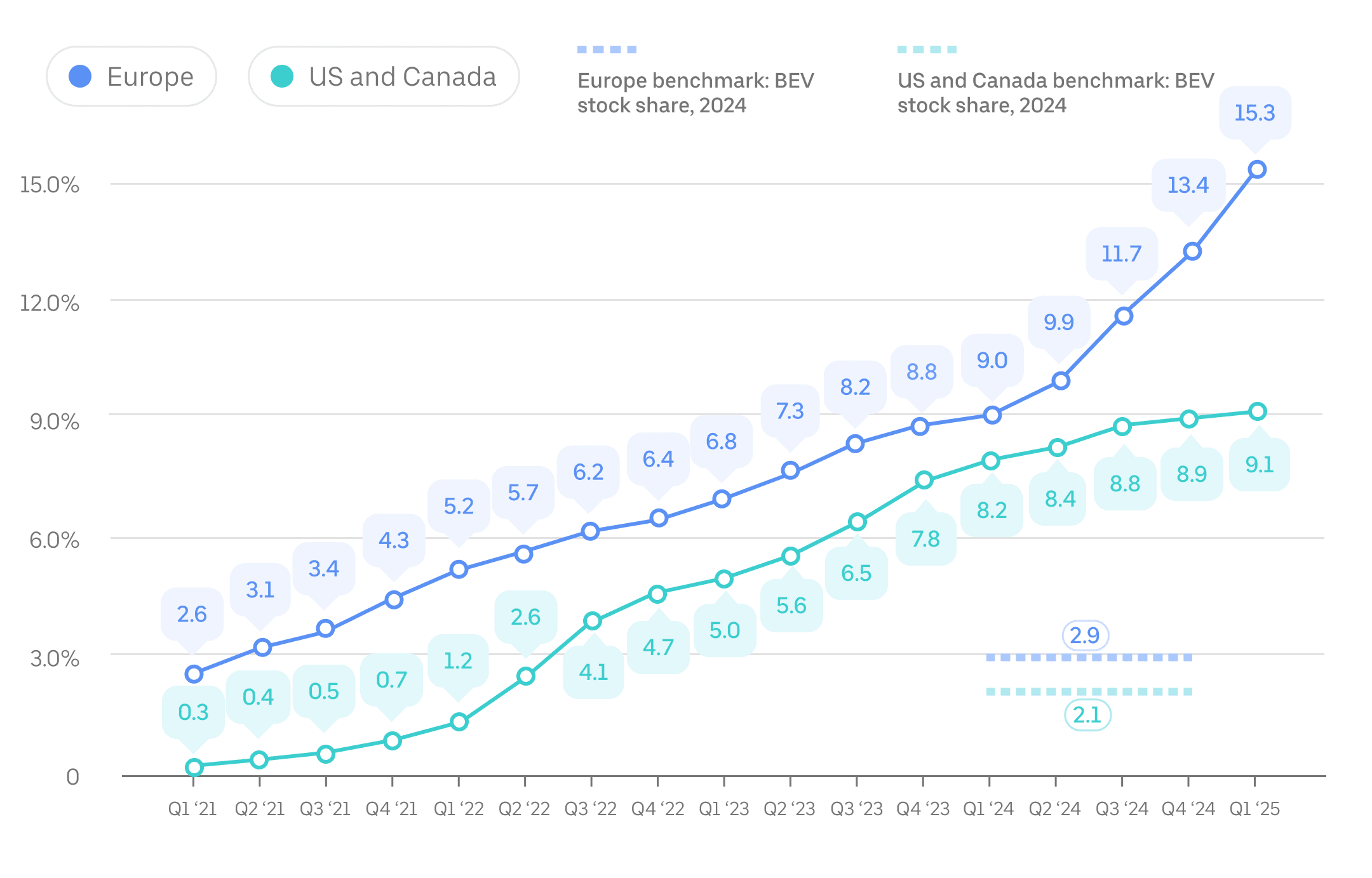Aktuálne informácie o elektrifikácii Uberu
„Pri dosahovaní našich ambicióznych cieľov vytvoriť platformu mobility s nulovými emisiami sme výrazne pokročili. Uber je dnes celosvetovo najrozšírenejšou platformou pre jazdy s nulovými emisiami a vodiči v USA, Kanade a Európe využívajú elektrické vozidlá až 5-krát častejšie než priemerní motoristi.“
Rebecca Tinucci, globálna riaditeľka pre elektrifikáciu a udržateľnosť v Uberi
Aktuálne informácie za 1. štvrťrok 2025: Na tejto stránke sú uvedené metriky ciest absolvovaných cez Uber vozidlami so spaľovacím motorom (ICE) a vozidlami s nulovými emisiami (ZEV, ako sú batériové elektrické vozidlá) od začiatku prvého štvrťroka 2021 do konca prvého štvrťroka 2025. Upozorňujeme, že táto správa zahŕňa iba mobilitu Uberu (zdieľané jazdy).
Sledovanie našej cesty k nulovým emisiám
Od stanovenia našich ambicióznych cieľov vytvoriť platformu s nulovými emisiami ubehlo už päť rokov a dosiahli sme zmysluplný pokrok. Uber je dnes celosvetovo najrozšírenejšou platformou pre jazdy s nulovými emisiami a vodiči v USA, Kanade a Európe využívajú elektrické vozidlá až 5-krát častejšie než priemerní motoristi.
Prostredníctvom stimulov, partnerstiev a vylepšení produktov sme investovali stovky miliónov dolárov, aby sme pomohli vodičom, ktorí chcú prejsť na elektrické vozidlá – a vypláca sa to. Čoraz častejšie zažívajú cestujúci svoju prvú jazdu elektrickým vozidlom práve cez Uber, čo pomáha štandardizovať a urýchliť prijatie elektrickej dopravy na celom svete.
Naše údaje ukazujú, že pokrok v oblasti elektrických vozidiel sa zrýchľuje, keď štát a odvetvie spolupracujú na prispôsobení ekonomiky. V mestách ako Londýn, Vancouver a Amsterdam, kde panuje súlad premyslenej politiky, investícií v odvetví a silnej nabíjacej siete, sa teraz viac ako 1 z 3. míľ cez Uberi prejde na elektrický pohon.
Napriek tomuto významnému pokroku však stále zostávajú veľké prekážky, ktoré bránia úplnému dosiahnutiu našich cieľov. Vysoké počiatočné náklady na elektrické vozidlá, obmedzený prístup k nabíjaniu a nekonzistentná podpora zo strany politík naďalej spomaľujú prijatie. Na základe súčasných trendov nedokážeme splniť naše zostávajúce ciele v oblasti mobility a doručovania pre rok 2025 a bez dôraznejšieho a koordinovaného postupu štátnej správy a odvetvia nedosiahneme ani naše ciele pre rok 2030.
Ako hovoríme od začiatku, klíma je tímový šport a pokrok závisí od kolektívneho zakročenia. Preto sa čoraz viac sústredíme predovšetkým na mestá, v ktorých idú verejné a súkromné investície ruka v ruke.
Hoci sú mnohé kľúčové faktory mimo našej kontroly, sme naďalej odhodlaní tento prechod dosiahnuť – nielen preto, že je správna vec, ale aj preto, že prináša priame a strategické obchodné benefity. Tisíce vodičov po celom svete si domov odnášajú viac peňazí vďaka nižším nákladom na prevádzku elektrických vozidiel a vysokému dopytu cestujúcich po elektrických vozidlách. Cestujúci hlásia väčšiu spokojnosť s elektrickými vozidlami a elektrické vozidlá si vyberajú čoraz viac.
A napokon, budúcnosť je spoločná, elektrická a autonómna – a prichádzajúca vlna autonómnych (elektrických) vozidiel bude mať veľký vplyv na dosiahnutie našich cieľov v oblasti udržateľnosti.
V našich najnovších aktuálnych informáciách nižšie načrtávame doterajší pokrok, kľúčové štatistiky a oblasti zamerania na rok 2025 a nasledujúce roky.
__
Rebecca Tinucci, globálna riaditeľka pre elektrifikáciu a udržateľnosť v Uberi
7. máj 2025
Vodiči vozidiel ZEV
V 1. štvrťroku 2025 bolo celosvetovo v aplikácii Uber aktívnych viac ako 230 000 vodičov ZEV. To o viac ako 60 % prevyšuje výsledok v rovnakom období minulého roka.

Metrika: Priemerní aktívni vodiči ZEV za mesiac cez Uber, podľa štvrťroka, od 1. štvrťroka 2021. Vodiči, ktorí používajú aplikáciu Uber, sa počítajú ako aktívni v danom mesiaci, ak v tomto kalendárnom mesiaci absolvovali aspoň jednu cestu.
Cesty ZEV
V 1. štvrťroku 2025 absolvovali vodiči ZEV cez Uber viac ako 105 miliónov ciest bez emisií, čo o viac ako 60 % prevyšuje počet absolvovaných jázd ZEV cez Uber za rovnaké obdobie minulého roka. To je v priemere viac ako 13 ciest ZEV cez Uber každú sekundu.

Metrika: Počet ciest dohodnutých v aplikácii Uber a absolvovaných vodičmi ZEV podľa štvrťroka od 1. štvrťroka 2021.
Príjem ZEV
V 1. štvrťroku 2025 vytvorili vodiči ZEV podiel 15,3 % zo všetkých najazdených kilometrov v Európe a 9,1 % zo všetkých najazdených kilometrov v Kanade a USA, čo je úroveň mnohonásobne vyššia ako úroveň bežnej verejnosti. Údaje uverejnené v Správe agentúry BloombergNEF z roku 2024 potvrdzujú, že vodiči Uberu v Európe využívali ZEV približne 5-krát častejšie ako bežní motoristi.
Za posledné 4 roky bol priemerný ročný nárast podielu najazdených kilometrov čisto na elektrický pohon cez Uber v Európe 3,1 percentuálneho bodu a v USA a Kanade 2,2 percentuálneho bodu. Najvyšší a najnižší ročný prírastok zaznamenaný v tomto období sa vyskytol v minulom roku: od 1. štvrťroka 2024 vyskočilo využívanie ZEV v Európe o viac ako 6 percentuálnych bodov a v USA a Kanade o niečo menej ako 1.

Metrika: Podiel precestovaných míľ počas cesty vozidiel ZEV v porovnaní so všetkými míľami počas cesty zoradenými v aplikácii Uber podľa štvrťroka od 1. štvrťroka 2021. Referenčné údaje pre Kanadu, USA a Európu pochádzajú z roku 2024 (najaktuálnejšie dostupné v čase vypracovania týchto aktuálnych informácií) a sú získané z portálu Medzinárodnej agentúry pre energetiku. „BEV“ označuje batériové elektrické vozidlá.
Uhlíková intenzita cestujúcich
V roku 2024 vytvoril každý kilometer precestovaný cestujúcim cez Uber v priemere 197 g CO₂ v Európe (alebo 123 g CO₂ na kilometer) a 340 g CO₂ v USA a Kanade (alebo 212 g CO₂ na kilometer). V porovnaní s rokom 2021 táto metrika uhlíkovej intenzity cestujúcich klesla o takmer 14 % v Európe a 6 % v USA a Kanade.
Uhlíková intenzita cestujúcich v Európe, USA a Kanade od roku 2023 do roku 2024 mierne vzrástla v dôsledku menšieho zníženia priemernej obsadenosti cestujúcich a zvýšenia „jázd naprázdno“ (počet najazdených kilometrov pred vyzdvihnutím cestujúcich a na ceste k nim).
Metrika: Uhlíková intenzita cestujúcich alebo odhadované CO₂ v gramoch na precestovanú míľu cestujúceho je ročná metrika efektívnosti, ktorú používa spoločnosť Uber – a čoraz viac aj štátna správa a firmy po celom svete. V prípade zdieľania jázd alebo akejkoľvek služby mobility na vyžiadanie sa do výpočtu zohľadňujú emisie produkované akoukoľvek míľou počas jazdy naprázdno.
Ďalšie informácie o spôsobe výpočtu uhlíkovej intenzity cestujúcich nájdeš v našom dokumente metodiky. Upozorňujeme, že výrazne nižšia priemerná spotreba paliva vozidiel na platforme Uber v Európe v porovnaní s USA a Kanadou vysvetľuje väčšinu rozdielu v uhlíkovej intenzite v týchto 2 geografických oblastiach. Hoci je skladba vozidiel, ktoré vodiči používajú v aplikácii Uber v Európe, efektívnejšia s vyšším podielom ZEV a hybridných vozidiel, k tomuto rozdielu prispievajú aj prísnejšie normy oznamovania spotreby paliva v USA. Okrem toho nemáme prístup k dostatočným vstupným údajom na výpočet uhlíkovej intenzity cestujúcich za cesty absolvované na európskych trhoch pred rokom 2021.
Prehľady a podrobné analýzy
Elektrické vozidlá pre každého: vyvážené prijatie vyvíjajúcej sa technológie (2024)
Udržateľnosť ako lepšia voľba (2024)
Ako pomôcť podporiť elektrickú mobilitu v Európe (2024)
Úspora emisií vďaka udržateľným trasám (2023)
Prečo sa jazda cez spoločnosť Uber zásadne líši od súkromného auta (2021)
Meranie mobility z hľadiska uhlíkovej náročnosti (2019)
Časté otázky
- Čo obsahujú Aktuálne informácie o elektrifikácii od Uberu?
Naše aktuálne informácie o elektrifikácii poskytujú zainteresovaným stranám metriky založené na výkonnosti týkajúce sa emisií uhlíka a elektrifikácie pri cestách osobnými vozidlami, ktoré podporuje aplikácia Uber.
- Prečo vydávate túto správu?
Tieto aktuálne informácie, ktoré vychádzajú z používania našej platformy pre mobilitu v reálnom svete, pomáhajú zvýšiť transparentnosť vplyvu našej elektrifikácie a pomáhajú nám zlepšiť naše úsilie o podporu efektívnosti na našej platforme.
- Aké kľúčové miery používate pri vypracúvaní aktuálnych informácií o elektrifikácii?
Medzi metriky patria:
- Používanie ZEV vodičmi cez spoločnosť Uber (podiel míľ alebo kilometrov absolvovaných počas cesty na vozidlách ZEV), ktorým sa meria náš pokrok smerom k nášmu cieľu dosiahnuť do roku 2040 mobilitu s len nulovými emisiami cez spoločnosť Uber na celom svete
- Uhlíková intenzita cestujúcich, ktorá meria emisie z každej prejdenej míle
- Ako tieto aktuálne informácie zlepšia znižovanie emisií a využívanie možností elektrifikácie pri jazdách cez Uber?
Máme odvážne ambície znížiť uhlíkovú intenzitu cestujúcich z ciest a zvýšiť využitie vozidiel s nulovými emisiami pri jazdách cez Uber. Meranie a transparentnosť pokroku sú na našej ceste dôležité kroky.
- Využívajú cestujúci cesty cez Uber namiesto nízkouhlíkových možností ako verejná doprava?
Jazdy cez aplikáciu Uber sú jednou z mnohých možností dopravy, ktoré majú ľudia hľadajúci možnosti jazdy k dispozícii. Výber cesty do veľkej miery závisí od rôznych podmienok na miestnom trhu. Naša analýza s údajmi amerického národného prieskumu domácností o cestovaní preukazuje, že vyššie využívanie najudržateľnejších spôsobov dopravy na domácnosť (preprava, chôdza a cyklistika) zodpovedá vyššiemu využívaniu zdieľaných jázd a iných riešení na vyžiadanie.
- Budete merať rovnaké údaje pre iné krajiny alebo regióny po celom svete?
Mnohé z uvedených metrík teraz pokrývajú všetky cesty cestujúcich absolvované cez aplikáciu Uber na celom svete. Dodržiavame pravidlá pravidelného oznamovania emisií uhlíka a ďalších oblastí vplyvu, ktoré vyplývajú z ciest cez Uber.
- Ako často očakávate, že budete poskytovať Aktuálne informácie o elektrifikácii od Uberu?
Metriky aktualizujeme aspoň raz ročne a niektoré metriky môžeme aktualizovať aj častejšie. Metriky emisií (napr. uhlíkovú intenzitu cestujúcich) zverejníme každý rok agregované podľa kalendárneho roka.
- Čo sa myslí pod pojmom „vozidlo s nulovými emisiami“?
Pojem „vozidlo s nulovými emisiami“ (ZEV) používame rovnako ako Kalifornská rada pre vzdušné zdroje (CARB) a Doprava a životné prostredie v Európe (T&E): označujeme tak vozidlá, ktoré z palubného zdroja energie neprodukujú žiadne priame emisie CO₂ ani iné kritériá znečisťujúce ovzdušie (napríklad NOx, tuhé častice, CO₂ a SOx). Čitateľ má zvážiť aj regionálne variácie podľa vlastného uváženia.
Vodiči, ktorí používajú aplikáciu Uber, dnes používajú 2 typy vozidiel ZEV: batériové elektrické vozidlá (BEV) a veľmi príležitostne elektrické vozidlá na vodíkový pohon s palivovými článkami (FCEV).
Samozrejme, „nula“ vo vozidlách ZEV sa vzťahuje na nulové emisie z povestného „výfuku“ vozidla a nie nevyhnutne na všetky emisie, ktoré možno pripísať od výroby až po likvidáciu vozidla a jeho zdroja energie. Koniec koncov však analýzy životného cyklu nezávislými odborníkmi ukazujú, že „emisie počas životnosti priemerných registrovaných elektromobilov so stredne veľkou batériou v súčasnosti sú už teraz nižšie ako porovnateľné benzínové autá o 66 % – 69 % v Európe, o 60 % – 68 % v Spojených štátoch a o 37 % – 45 % v Číne, a 19 % – 34 % v Indii.“
- Budete merať vplyv na doručovanie?
Naše aktuálne informácie o elektrifikácii v súčasnosti pokrýva metriky elektrifikácie a emisií iba v rámci odvetvia mobility (zdieľané jazdy). Do budúcnosti chceme zahrnúť náš pokrok v oblasti emisií z doručovania a elektrifikácie.
Pokiaľ ide o obaly, Uber naďalej investuje do pomoci obchodníkom prejsť na udržateľné možnosti. Rovnako ako v prípade elektrifikácie, aj tu však pokrok závisí od kolektívnej činnosti. Sústredíme sa predovšetkým na mestá, v ktorých idú verejné a súkromné investície ruka v ruke. Vo Francúzsku je napríklad viac ako 60 % obalov používaných na platforme recyklovateľných, opätovne použiteľných alebo kompostovateľných, čo podporuje národná politika a miestne stimuly.
Hoci sme dosiahli pokrok, na základe súčasných trendov nemôžeme splniť všetky ciele na rok 2025 a naše ciele na rok 2030 sa nám nepodarí dosiahnuť bez dôraznejších a koordinovaných opatrení na úrovni štátnej správy a odvetvia.
Aj keď sú mnohé kľúčové faktory mimo našej kontroly, k tomuto prechodu sme naďalej pevne odhodlaní prispieť. Ak chceš vedieť viac o tom, ako Uber pristupuje k udržateľnejším obalom u obchodníkov, prečítaj si našu webovú stránku Uber Eats pre obchodníkov.
- Zverejňuje Uber emisie v rozsahu 1, 2 a 3 a ak áno, kde je ich možné nájsť?
Uber oznamuje emisie pre rozsah 1, 2 a 3 úradu CDP. Naše najnovšie hodnotenie nájdeš vo verejnom vyhľadávaní firemného hodnotenia od CDP. Nezávislá tretia strana len obmedzene zaručila tieto odhady emisií.
Na tejto webovej stránke a v súvisiacich informáciách, aktuálnych informáciách, správach a webových stránkach (ďalej len „správa“) predstavujeme naše plány a ciele do budúcnosti, ktoré sú ale spojené s množstvom rizík a neistôt. Skutočné výsledky sa totiž od tých očakávaných môžu výrazne líšiť. Okrem toho slúži táto správa iba na informačné účely. Nespoliehajte sa ňu pri obchodných rozhodnutiach ani akvizícii vozidiel. Na tieto vyhliadky do budúcnosti sa nadmerne nespoliehajte. Nezaväzujeme sa tieto informácie aktualizovať, pokiaľ si to nevyžaduje zákon. Ďalšie informácie o stratégii Uberu nájdeš na stránke investor.uber.com.
Niektoré údaje uverejnené v tejto správe boli zo strany LRQA zaručené len čiastkovo. V dôsledku metodiky zaokrúhľovania sa vyskytnú nezrovnalosti v údajoch.
Pojmy ako „vodiči“, „kuriéri“, „zarábať“, „vozidlo s nulovými emisiami“ a „udržateľné obaly“ v tejto správe sú používané všeobecne a riadia sa všeobecným používaním výrazov spoločnosti Uber Technologies, Inc. Čitateľ má zvážiť aj regionálne variácie týchto slov podľa vlastného uváženia.
Tu je prehľad využitia kompenzácií uhlíka spoločnosťou Uber.
Informácie